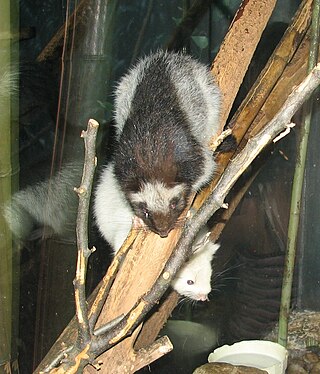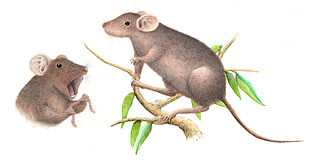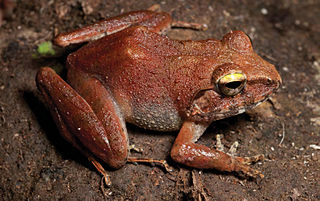
The Old World rats and mice, part of the subfamily Murinae in the family Muridae, comprise at least 519 species. Members of this subfamily are called murines. In terms of species richness, this subfamily is larger than all mammal families except the Cricetidae and Muridae, and is larger than all mammal orders except the bats and the remainder of the rodents.

The cloud rats or cloudrunners are a tribe (Phloeomyini) of arboreal and nocturnal herbivorous rodents endemic to the cloud forests of the Philippines. They belong to the family Muridae and include five genera: Batomys, Carpomys, Crateromys, Musseromys, and Phloeomys. They range in size from as large as 50 cm (20 in) to as small as 74 mm (2.9 in). Cloud rats are threatened by habitat loss and illegal hunting. Several species are endangered or critically endangered.

The Camiguin forest mouse is a forest mouse endemic to the island of Camiguin in the southern Philippines. It has large ears and eyes, a long tail and rusty-brown fur, and it feeds mostly on insects and seeds. This description is based on mice captured during a biological survey conducted in 1994 and 1995 high on the steep slopes of one of the island's volcanoes.

The shrewlike rats, genus Rhynchomys, also known as the tweezer-beaked rats are a group of unusual Old World rats found only on the island of Luzon in the Philippines. They look a great deal like shrews and are an example of convergent evolution. Shrewlike rats evolved to be vermivores and insectivores feeding on soft-bodied invertebrates associated with leaf litter.

The Luzon montane forest mouse is a species of rodent in the family Muridae, from the genus Apomys. It occurs only in the Philippines, where it has been found on the large northern island Luzon. It is most closely related to the large Mindoro forest mouse, which occurs on Mindoro. There may be another related species in the Sierra Madre, but this species is yet undescribed. The Luzon montane forest mouse is a relatively large, ground-dwelling rat with a tail that is quite short for its genus.

The large Mindoro forest mouse is a species of rodent in the family Muridae, from the genus Apomys. It is found only in the Philippines. Its natural habitat is subtropical or tropical moist montane forests. It is a large mouse with large feet, a long tail and an elongated snout which is morphologically unique within its genus. It is covered in soft fur which is mostly dark brown in colour. Its closest relative is thought to be the Luzon montane forest mouse, based on genetic and morphological similarities.

The long-nosed Luzon forest mouse, also known as the Pinatubo volcano mouse, is a species of rodent in the family Muridae.

The southern giant slender-tailed cloud rat or southern Luzon giant cloud rat, also known as bugkon in Filipino, is a vulnerable species of rodent in the family Muridae, found only in southern Luzon in the Philippines. It is dark brown, occasionally with some reddish, but lacking the light-coloured sections usually seen in its close relative, the northern Luzon giant cloud rat. The southern giant slender-tailed cloud rat is a large rodent that has a total length of about 67–75 cm (26–30 in) and weighs 1.45–2.1 kg (3.2–4.6 lb).

Platymantis cagayanensis is a species of frog in the family Ceratobatrachidae. It is endemic to the Philippines, where it is found along the north coast of Luzon Island and on Palaui Island. It has been observed as high as 200 meters above sea level.

Platymantis taylori is a species of frogs in the family Ceratobatrachidae. It is endemic to the Philippines and is known from the Sierra Madre of northeastern Luzon. It has been observed between 100 and 400 meters above sea level.

The Katanglad shrew-mouse, also known as the Kitanglad shrew-mouse is a species of rodent in the family Muridae. It is known only from one specimen taken at 2250 m on Mount Kitanglad, Bukidnon Province, Philippines.

The Kalinga shrew mouse is a rodent of the genus Soricomys found in the northern province of Kalinga, island of Luzon, in the northern Philippines.
Musseromys is a genus of rodent, in the family Muridae, endemic to the Philippines. Four species are known, all from Luzon:

Banahaw tree mouse is a species of rodent in the family of Muridae. It is named after Mount Banahaw in Luzon, Philippines.
Danilo S. Balete, also known as Danny Balete, was a Filipino zoologist and biologist. His is known for his work on the Philippines' endemic mammal species. He pursued the question of what determines species diversity. The research by Balete and his team overturned previously held notions that diversity decreased in mountainous regions, showing that harsh environments could generate, rather than suppress, species diversity.

The Mount Tapulao forest mouse is a forest mouse endemic to the Mount Tapulao area in the Philippines. It is named after the American zoologist Barbara Elaine Russell Brown.
The Sierra Madre tree-mouse is a species of rodent in the family Muridae. It is found in the forest of the northern Sierra Madre in Luzon, Philippines.
The Mount Pulag tree-mouse is a species of rodent in the family Muridae. It is found on Mount Pulag in Luzon, Philippines.

The Kampalili moss mouse, also known as the Kampalili tarsomys, is a species of rodent in the family Muridae. At just 5 in (130 mm) long, it is the smallest species of the Mindanao-endemic genus Tarsomys, and the third to be discovered. The species was distinguished from the other members of its genus, namely Tarsomys apoensis and T. echinatus, by the smaller size of its body, significantly shorter tail, smaller size of hind feet, the soft and dense pelage that is darker in color, its smaller skull that has a broader zygomatic plate, shorter incisive foramina, and much longer auditory bullae.















